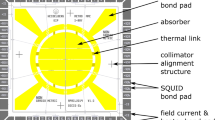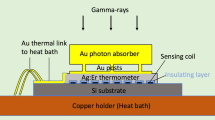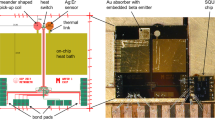Abstract
Total decay energy spectrometry with cryogenic detectors is a promising technique for radionuclide analysis of α-emitting nuclides. The radioactive sample is embedded in the detector absorber, and the total decay energy for each disintegration is measured as a temperature elevation. We are developing this technique with metallic magnetic calorimeters (MMCs). The main condition of this technique is a detection efficiency close to unity. However, some α-emitting nuclides emit intense γ-rays that can partially escape from the absorber. So a feasibility study for several nuclides has been carried out based on Monte Carlo simulations of the detection efficiency and numerical calculations of the expected energy resolution to identify the radionuclides that can potentially be measured. Furthermore, an MMC prototype has been built and tested. The total decay energy spectrum of Po-210 was measured, and a FWHM energy resolution of 1.25 keV at 5.4 MeV was obtained and a Gaussian width at half maximum of 0.827 (5) keV. The baseline FWHM energy resolution is 207 eV, consistent with the resolution obtained on low-energy L X-rays in the same spectrum at 14 keV.


Similar content being viewed by others
Notes
The α-emitting nuclides were chosen based on not having too short a half-life compared with the experiment duration of between a few hours and several days. Very long half-life nuclides would probably be problematic due to the large amount of material required to provide sufficient activity, but the problem of source preparation is not considered in this paper.
Two stage SQUID from Magnicon GmbH with an input coil inductance of 27 nH.
References
S.-J. Lee et al., J. Phys. G Nucl. Part. Phys. 37, 055103 (2010). https://doi.org/10.1088/0954-3899/37/5/055103
K.E. Koehler et al., IEEE Trans. Nucl. Sci. 60, 624–629 (2013). https://doi.org/10.1109/TNS.2012.2225639
M. Loidl et al., Appl. Radiat. Isot. 68(7–8), 1454–1457 (2010). https://doi.org/10.1016/j.apradiso.2009.11.054
A. Fleischmann, C. Enss, G. Seidel, in Cryogenic Particle Detection, Topics in Applied Physics, vol. 99, ed. by C. Enss (Springer, Berlin, 2005), pp. 151–216
PENELOPE-2014. A code system for Monte Carlo simulation of electron and photon transport—Workshop Barcelona, Spain 29 June–3 July 2015 (NEA/NSC/DOC(2015)3)
E. García-Toraño, et al. Nucl. Instrum. Methods Phys. Res. B 396, 43–49 (2017). https://doi.org/10.1016/j.nimb.2017.02.002
R.D. Horansky et al., IEEE Trans. Appl. Supercond. 23, 2101104 (2013). https://doi.org/10.1109/TASC.2013.2237938
Acknowledgements
We are grateful to Yong-Hamb Kim and his colleagues from KRISS and IBS for the valuable discussions and comments about this development.
Author information
Authors and Affiliations
Corresponding author
Rights and permissions
About this article
Cite this article
Rodrigues, M., Laarraj, M., Loidl, M. et al. Development of Total Decay Energy Spectrometry of α-Emitting Radionuclides Using Metallic Magnetic Calorimeters. J Low Temp Phys 193, 1263–1268 (2018). https://doi.org/10.1007/s10909-018-2008-y
Received:
Accepted:
Published:
Issue Date:
DOI: https://doi.org/10.1007/s10909-018-2008-y




